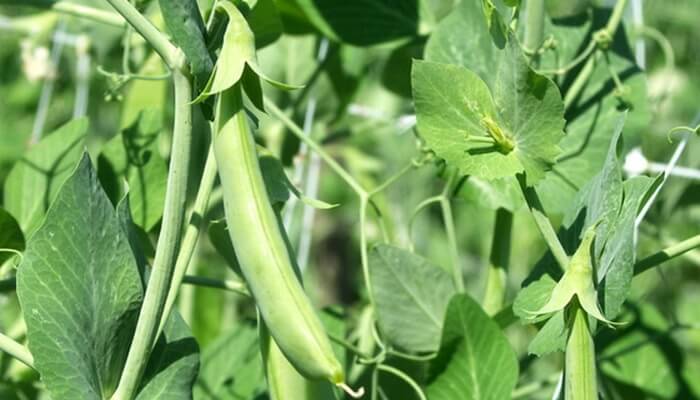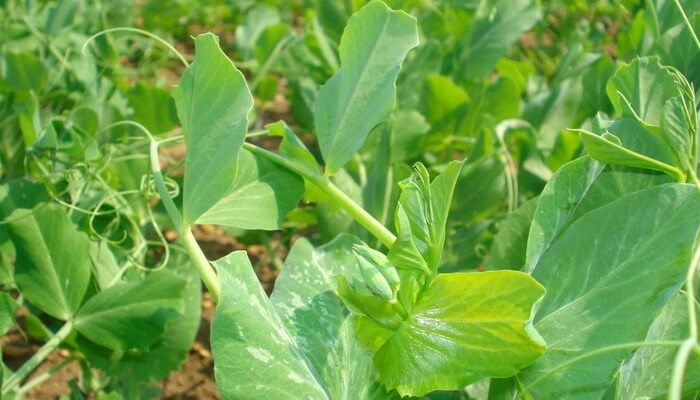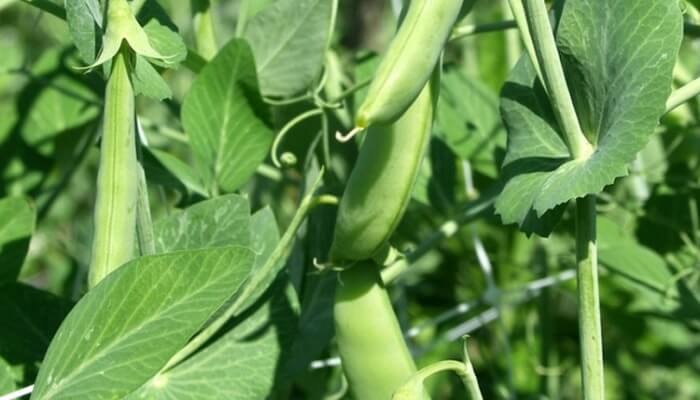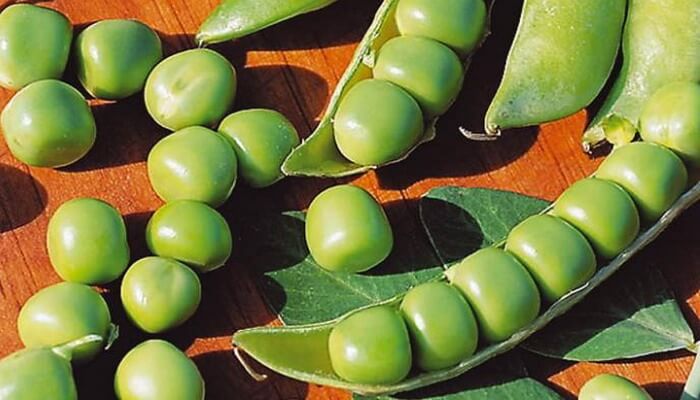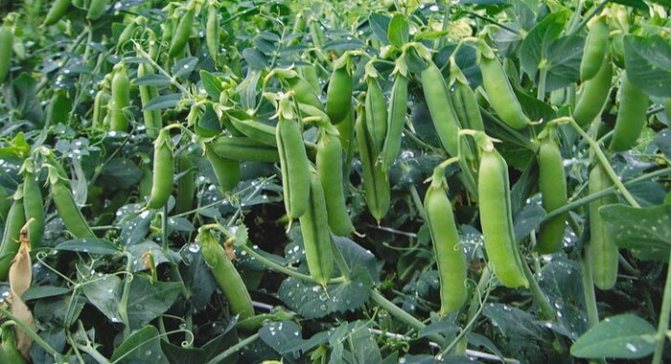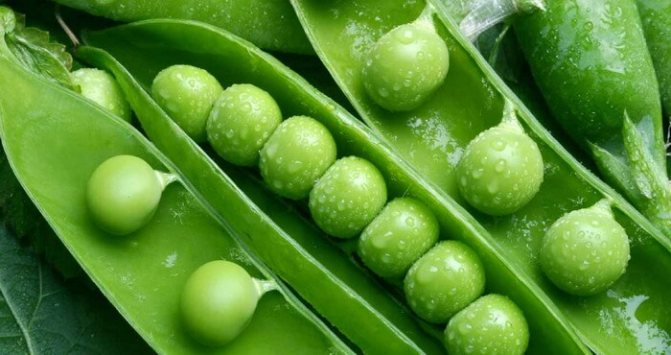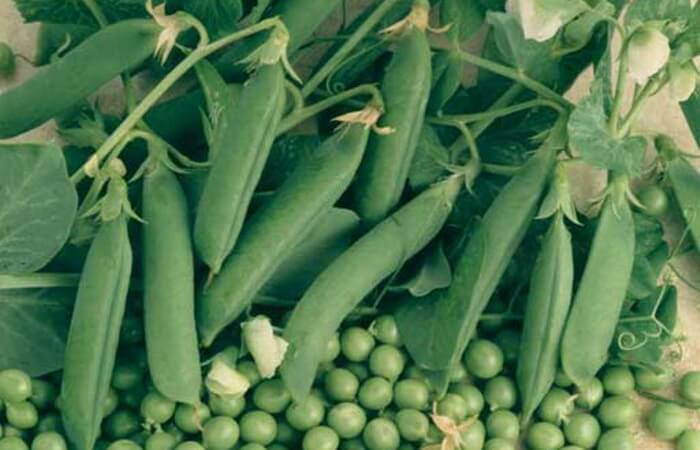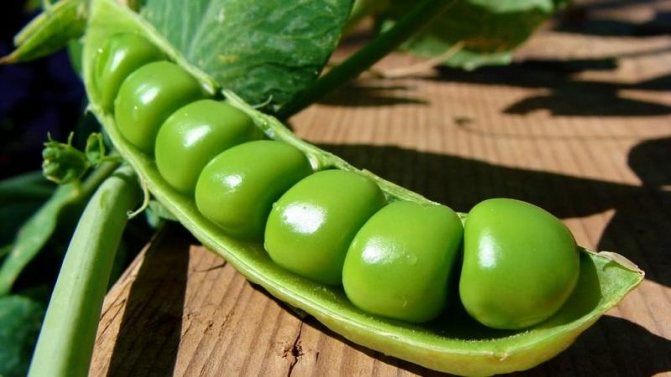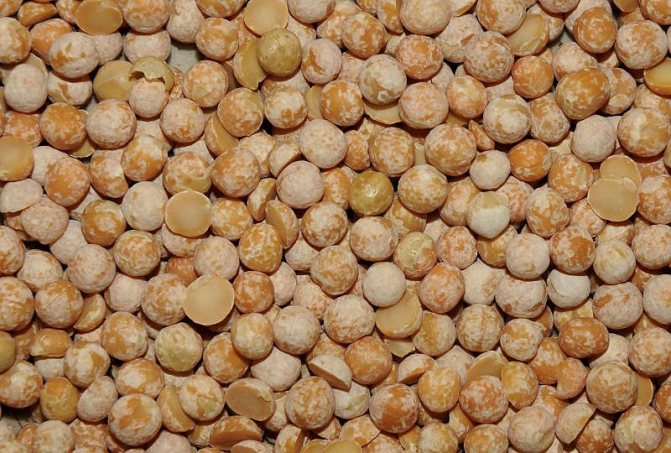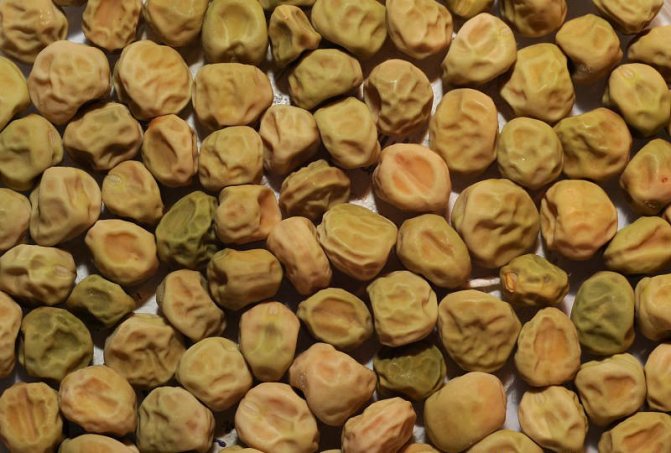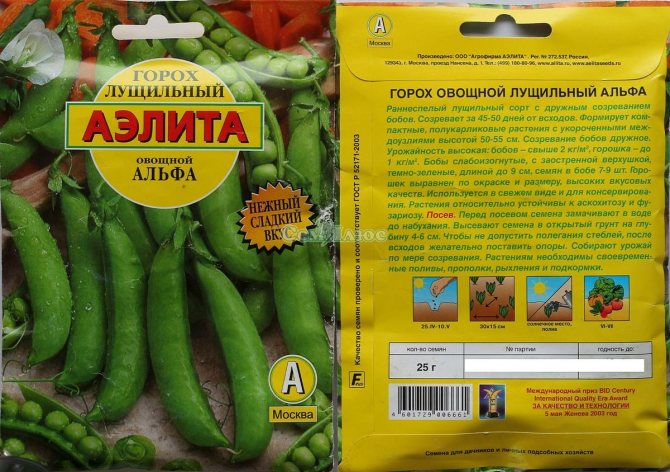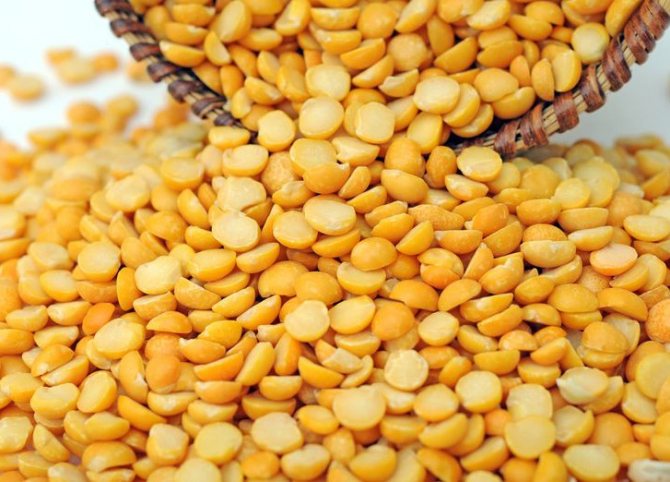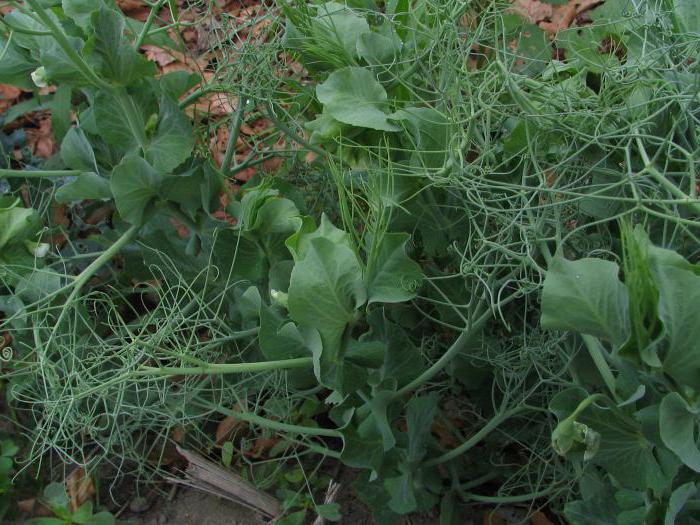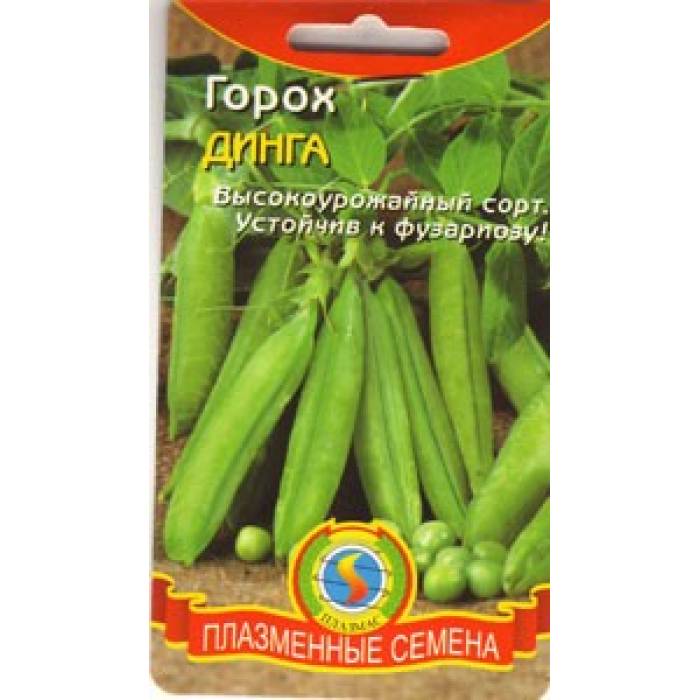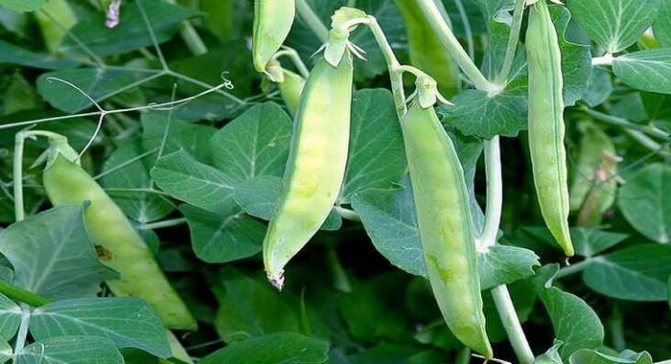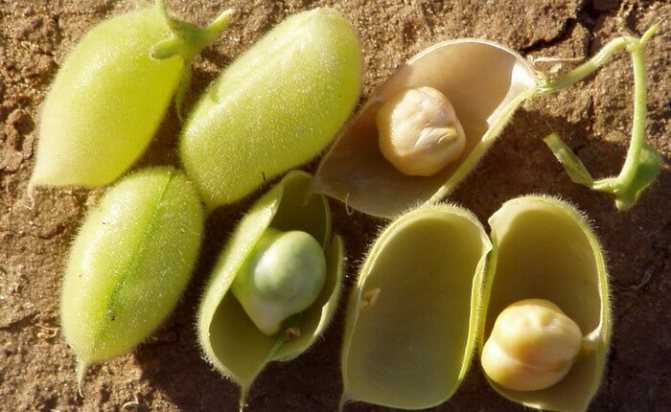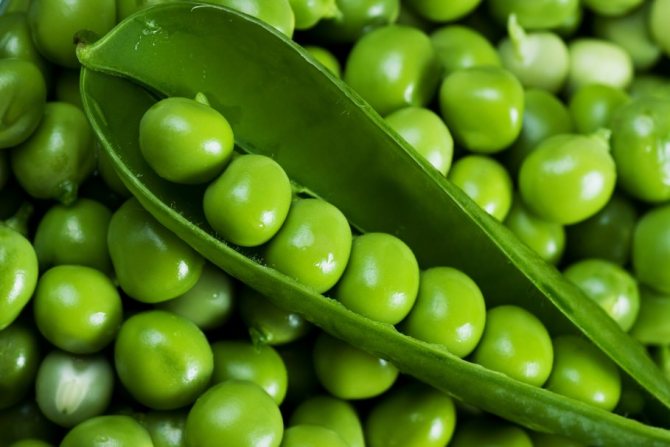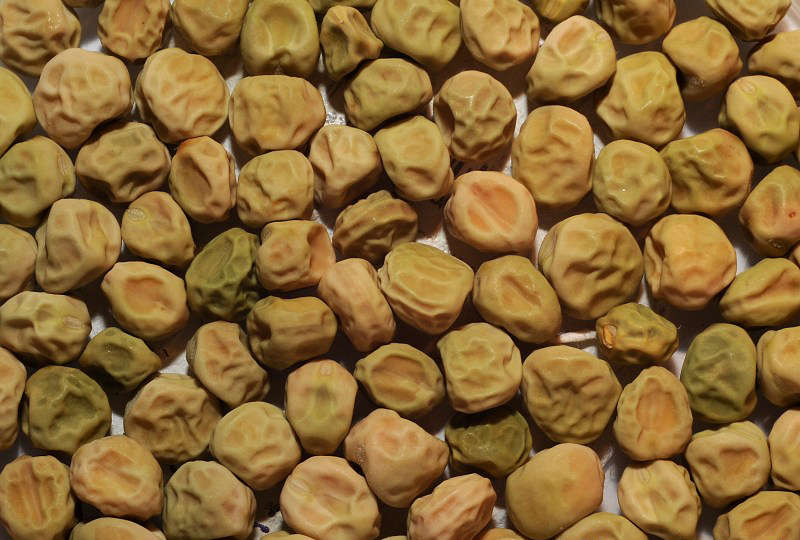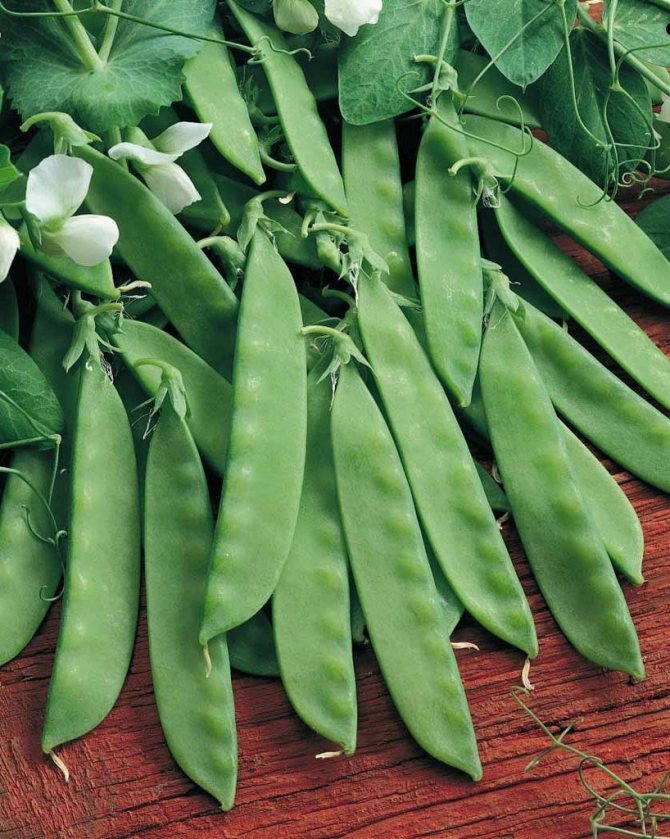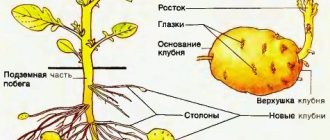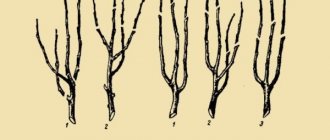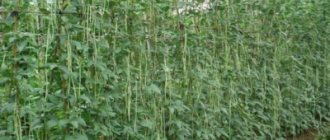The main types of peas
By the timing of ripening, it happens:
- early ripening - 50-55 days (Gavrish);
- early ripe - 56-60 days (Sweet friend);
- mid-season - 64-70 days (Ilovetsky; Sugar pod);
- medium late - 61-70 days (Somerwood; Aksaysky);
- late - up to 100 days (Delilah).
Plants are distinguished by height as:
- undersized - 40-70 cm (Children's joy);
- medium-sized - 70-115 cm (Fokor);
- tall - 115-250 cm (Salamanca).
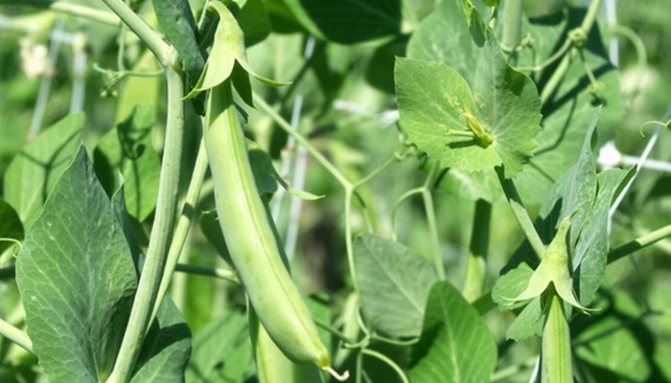
Pea varieties
Pea shelling varieties


Shell peas
Interesting!
Hulled peas have smooth grains. He is going young, so to speak unripe, while still green. These varieties of peas are used for canning, freezing, preparing a variety of dishes: soups, mashed potatoes, cereals.
- "First Early" is a peeling variety that ripens 52 days after germination. Maturation is amicable. During the growing season, the stem grows up to 70 cm, The leaves are simple, typical, the flowers are medium, white. The pod is curved, green with a pointed tip. The seeds are wrinkled. The taste is excellent.
- "Primrose" is an ultra-early species that gives the first harvest in May or early June, with timely planting. The stem grows up to 50-60 cm. The pods are straight or slightly curved with 6-8 seeds inside. The peas are delicious, sweet, lined in the pod. Contains a lot of sugar and nutrients. Good fresh, but also good for processing.
- Vera is an early variety (50 days on average) with cerebral grains. It is used fresh, for canning, preparation of various dishes. Stems grow up to 55-65 cm. The pods are straight, may be slightly curved, but not strongly. The length of the pod is 6-9 cm, with 8-9 peas, but sometimes less. The parchment layer of the pod is well developed. The yield per square meter reaches 1.2 kg.
- "Salyut" - shelling cereal peas, early ripening. It grows up to 60-85 cm, usually not on a trellis, but just like that. For the convenience of collection, it is usually simply tied up 1-2 times. Pods 8-9 cm each, contain 7-9 tender and sweet green peas. This is a versatile variety that can be used both for canning and preparing a variety of dishes, and for consumption fresh, raw.
How to choose peas: useful tips and tricks
Now there is a huge selection of excellent varieties... Choose the appropriate option based on your taste preferences and growing characteristics in the region.
Grow this useful culture on your site is completely easy, you just need to follow the basic rules:
- To get an excellent harvest of peas, we recommend choosing an open, sunny place where water does not stagnate.
- Before sowing, it is better to fertilize the bed well using complex fertilizers or humus and ash.
- Remember that the plant does not like acidic soils. If this is your case, add lime to the mail before sowing.
- Planting seeds is usually done outdoors from March to June, as soon as the soil warms up to 10 ° C.
- Seeds require a lot of moisture to germinate.
- Peas do not tolerate heat well, so planting early is the right decision.
- During the germination phase, birds are especially dangerous for seeds, so it is better to cover the seeds with non-woven material.
- During the growing season, peas will need top dressing, weed removal and watering.
- Peas are an excellent precursor for other vegetable crops, they have a beneficial effect on the soil.


Types of seed peas
Peas are smooth-grain. This means that its peas remain smooth after drying. The most popular varieties of this variety:
- Adagumsky;
- Uladovsky anniversary.
There is also cerebral, that is, after drying, the peas have a wrinkled shape, similar to the brain. The following varieties have such a feature:
- Voronezh green;
- Calvedon Miracle;
- Gloriosa peas;
- Hawa pearls.
The sugar pea beans are very fleshy and tender. They can be eaten together with the valves, in which the fiber content is less than in other types of peas. As the peas ripen (they can already be consumed separately), the juiciness of the valves decreases. This variety is more of a treat than food and is therefore less commonly grown.
Important! It is very beneficial for children to eat peas to maintain normal growth, muscle tone and to stimulate mental activity.
The best varieties of sugar peas:
- Zhegalova 112;
- Children's sugar.
Sowing peas are a species of the genus Peas of the legume family. It is an annual climbing plant that has been cultivated by humans since ancient times. Paleobotanists claim that dried peas were found in buildings from the Stone and Bronze Ages.
In the Middle Ages, peas were one of the main food products of mankind. At that time, people only used its fully ripe seeds, from which they made porridge and soups. Green peas began to be eaten only in the 17th century. It is most widely used in France and Great Britain. The invention of conservation and freezing played a significant role in the popularization of unripe peas. Thanks to these methods of preparing food, we got the opportunity to eat them all year round, and not just in the summer.
Harvesting
Harvesting begins as soon as the fruit is ready. On average, the harvesting period for whole beans (per shoulder) is produced in 10 days, and for green peas 15 days after the end of flowering. In the future, this should be done every 2-3 days. Overripe fruits slow down the setting and growth of new ones. Brain sugar beans are consumed as a whole.
If you need to get grain, after the lower beans have ripened, the plant is cut and hung out to dry in a ventilated room. After 2 weeks, the beans are husked, and the grains are dried.
Tags: legumes
Brain Pea Varieties
Check out these articles as well
- Onion variety Hercules
- Cherry Valley duck breed
- Diseases of apple trees and the fight against them
- Repaired strawberries - the best varieties


Brain peas
Brain peas differ from other species in the type of their beans. They are wrinkled, uneven, hence the name. Pea varieties of this type are sweet, consumed or used for processing while green.
- "Children's Delight" - wrinkled, brain peas. Is very early. Grows up to 60 cm in height. The pods grow an average of 10 cm, inside 9-10 peas. The peas are small, green, sweet. There is immunity to Fusarium.
- Green Stream ripens early. Grows up to 50 cm, pods are straight, not very large, contain 7-10 seeds. Wrinkled, green, angular polka dots. Used for fresh consumption, canning. Differs in amicable maturation, good immunity.
- "Emerald Pearl" is a mid-season species that ripens in 60-70 days. The vine is quite strong, so this variety is sometimes grown just like that, not on trellises. Pods up to 11 cm in length, contain large wrinkled peas. The variety is very tasty, with a fresh aftertaste, high juice content. Consumption is universal.
- "Violena" - early ripening cereal peas. Grows in a small bush up to 70 cm in height. The pods are green, about 8 cm, each with 7-8 wrinkled peas. It is used for fresh consumption, as the taste is sweet, pleasant, the structure of the grains is delicate, but it is also suitable for processing.
Unusual types of peas
Peas have many varieties, for example, there are varieties without leaves.Due to the intertwined whiskers, plants almost do not need to put up supports, but the yield of leafless peas is unstable, depending on the amount of moisture in the soil and air.
Common varieties of leafless peas:
- Ailla;
- Slider;
- Aksai mustache;
- Yamal;
- Pharaoh;
- Rocket peas.
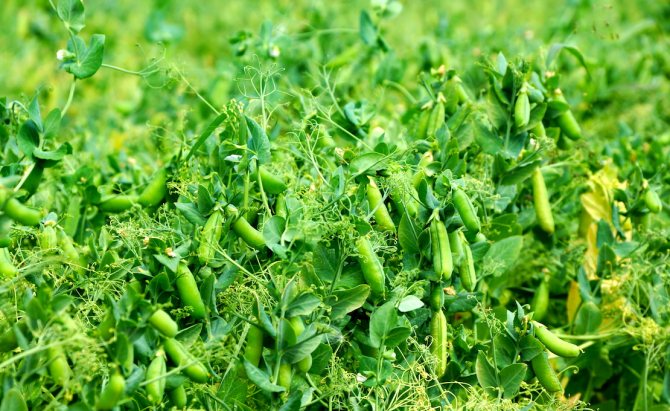

Aksai mustache
There are peas of unusual color or size:
- Purple sugar. Such peas bloom in a beautiful purple color with a pleasant smell. The beans are also purple, they look beautiful in the green foliage. The 8 cm long pod contains 8-9 tasty greenish-purple peas. This tall, mid-season variety has a height of 1.5 m.
- Red is another type of unusual pea. It has a thin stem and small grains. The small round peas range in color from dark orange to red. Red peas grow mainly in Asia.
- White peas differ from their congeners with platinum-colored inflorescences and light green grains.
- The Purple King is an early pea variety that has bright purple pods and green peas. Peas are consumed fresh and after heat treatment.
- Russian size. Its beans are more than 1 cm in diameter. These are large, tasty and sweet peas.
- Chickpea. Unusual varieties include chickpeas. The shape of its fruit resembles a ram's head. In ancient times, chickpeas were used not only for food, but also as a medicine. It is from it that the famous Azerbaijani piti soup is prepared.
- Soy. Another type of peas is Chinese oil peas - soybeans. Sauce, milk, meat, cheese are made from it, and also added to sweets.
- Meadow peas are a rank - another species of the legume family. It grows in Europe, USA and China. Contains ascorbic acid, minerals and vitamins. Used in the treatment of diseases such as bronchitis, pulmonary tuberculosis, colds, insomnia.


Purple king
Sugar peas
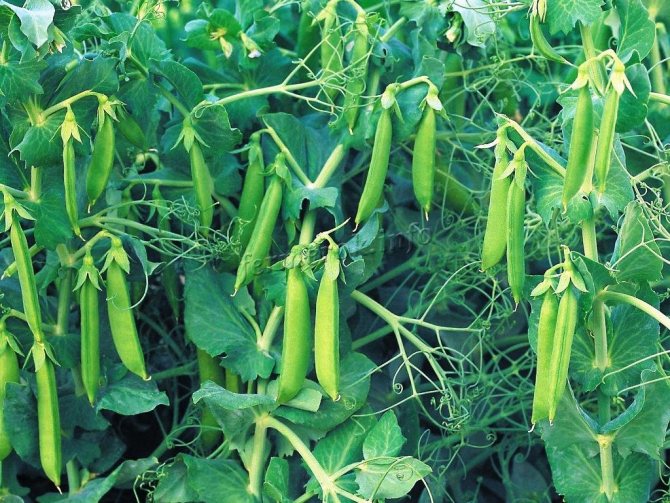

Sugar peas
Sugar peas produce fleshy, tender beans. They are best eaten fresh, while they are still green, small. These peas are edible not only with beans, but also with pods. So which sugar pea varieties stand out from the rest? We offer a description of the best sugar peas:
- "Honey scapula" - sugar, mid-early peas (60-75 days), fully consistent with its name. The peas are sweet as honey, and the pod is a bit like a shovel. The plant grows up to 75 cm. The pods are slightly curved or straight, up to 8 cm. There are 7-8 peas inside. As a rule, it is consumed fresh, although the use is in principle universal. Productivity 1.5 kg / m. sq.
- "Firstborn" is an early variety, 45 days pass from the moment of germination to technical ripeness. Maturation is amicable. The stem grows up to 120 cm. The pods are not too curved, of medium length, not wide, green in color. The peas are not very wrinkled, sweet, with a delicate texture. The use is universal. Productivity 0.5 kg / m. sq.
- "Zhegalova-112" is a hybrid obtained by Russian breeders. It is in great demand among summer residents and gardeners, since this variety uses not only grains, but also the pod itself. Each such bush ripens up to 50 pods per season, but the yield depends entirely on care and, mainly, on watering. Peas have a good immune system.
- Sugar 2 is a medium early species (55-65 days) with excellent taste and high yield. Grows up to 90 cm in height. Pods are typical, light green in color, without parchment layer, up to 10 cm long, curved. The peas are sweet, juicy, without hard fibers. Suitable for fresh consumption, beans are sweet, juicy, often used in salads, snacks.
- "Ambrosia" is an early variety. The vine grows up to 70 cm in height, no more. The pods are only slightly curved and contain 7-8 peas. The color of the pods is light green. It is used for fresh consumption and canning. At the same time, both the peas themselves and the pods can be included in the food, they are sweet, plump and fleshy.
- "Inexhaustible-195" is a mid-early variety.Maturation is always amicable. The type of seeds is cerebral. This variety ripens in 70-90 days. The stem grows to a maximum of 115 cm. The flowers are large, white, one on each peduncle. The pod is light green, with 6-7 beans inside. Seeds are yellow-green, yellow when overripe. The taste is excellent. Peas are sweet, juicy. The yield reaches 7.9 t / ha.
The best varieties of peas with photos and descriptions
Today there are many varieties of peas that differ from each other not only in the type of fruit, but also in the ripening period, the size of the bush and other characteristics. From this variety, each gardener can choose the crop that is most suitable for his site.
Peas do not need a lot of heat, so they are most often grown outdoors. Almost all varieties are suitable for this, but high-yielding and unpretentious representatives, not prone to lodging and shedding seeds, are in maximum demand. These qualities are especially important in industrial cultivation.
If unusual varieties are planted to decorate the garden, then there are varieties that are planted exclusively for food. They are considered proven, therefore they are cultivated from year to year. We are talking about:
- Vegetable peas Alpha. The description of the variety says that its ripening time takes 45-55 days. The height of the bush is from 1 to 1.5 m. Alfa peas are planted in grooves, the depth of which is 4 cm, the width between them is about 20 cm, in row spacing 6 cm. This is a high-yielding variety. You can collect up to 2.4 kg from 1 m².
- Ambrosia. Refers to early ripening varieties. Ripening period 54-56 days. It grows up to 70 cm, therefore props are required. A 10-centimeter greenish cone contains 8-10 sugar peas. Fruiting peas Ambrosia well, you can collect up to 1.5 kg from 1 m².
- Vera. A low-growing plant up to 65 cm, 6-9 peas in the beans. Fruitful variety: about 1 kg per 1 m².
- Oscar. Mid-season sugar peas. Fruits from 0.8 to 1 cm in diameter. This variety has an increased resistance to disease.
- Slider. It is a leafless, quickly ripe sugar pea. Ripening period 53-55 days. It grows up to 75 cm. The color of the slightly curved horn is light green. One pod contains up to 10 sugar peas. You can eat them together with the shutters. Its advantages include fast ripening, fruiting for a long period. There is no need to support.
- Altai emerald. Low-growing peas are classified as mid-early shelling varieties. From germination to technical maturity, 53-56 days pass. It is a compact bush plant 35-45 cm high. It has a saber-shaped bean about 10-15 cm. There are 6-8 peas in a pod. There are 6 to 12 horns on the bush. It can be planted in steps in 10-14 days, starting from the end of April to the end of June. Planting depth 3-4 cm, row spacing 25-30 cm. It needs watering and loosening.
- Peas Nikita. Another representative of leafless peas. These are early ripe peas with a height of 70 cm, ripening period of 53-55 days. It has a very long fruiting period, almost to frost. It has slightly curved, long green beans that contain up to 9 even, sweet peas.
- Peas Rocket. Mid-season leafless variety, growing season 68-95 days. Early sowing is recommended. Low-growing variety with a height of 46-85 cm.
- Golden eagle. An annual, self-pollinating cultivar, it belongs to the brain pea cultivars. Loves fertile, well-moisturized lands. Sowing and care, as well as for all types of peas.
- Sugar 2 belongs to the brain varieties. Medium late, ripening time 50-65 days. It has a straight bean with 9-11 peas, plant height about 70 cm. Resistant to diseases. It is consumed fresh and processed.
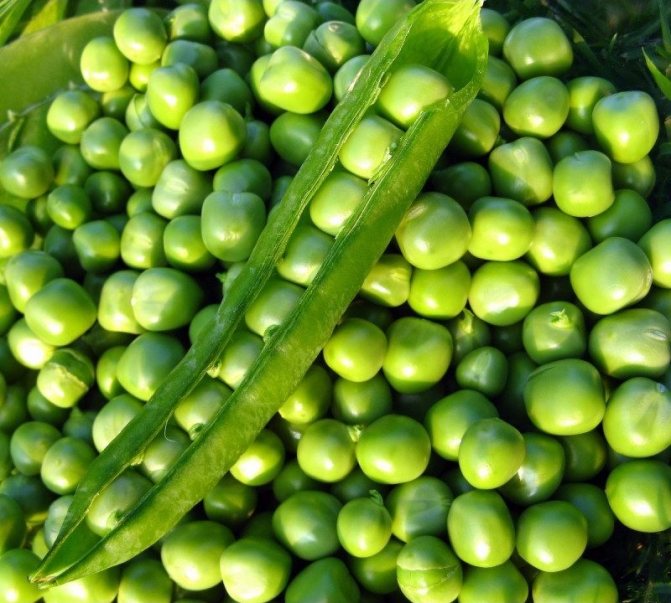

Pea Rocket
Both adults and children love to eat green peas. Practically in every vegetable garden there is a place for vegetable legumes, moreover, agricultural technology does not include complex measures.
An important component of a good harvest is the selection of a variety and high-quality pea seeds.
With the current assortment of seed, making a choice is not so easy, a description of the different varieties will help you with this.
In this article, you can familiarize yourself with the most popular varieties, the yield and quality of the fruits of which have been tested for years.
Peas Alpha
The ripening period of the Alpha variety is early, from the moment of germination of shoots above the soil surface to technical ripeness, 45-55 days pass. The variety has a stable yield (6-7 t / ha), resistance to fusarium, ascochitosis and other diseases.
The height of the bush in centimeters reaches 55, 2 beans are formed in each bosom, 5-9 seeds develop in a pod 7-9 in length.
Pea variety Alpha
The peculiarity of the culture lies in the high market value and taste due to the high sugar content in the composition.
When sowing, the scheme is used: row spacing - 20, the interval between seeds - 5, the depth of immersion of the peas - 3-4.
Sugar grade
Early ripening peas with a growing season of 55-60 days. The height of the bush reaches 50-70 cm, and therefore requires a garter. Pod parameters at the stage of technical ripeness: length - 7-8 cm, number of seeds - 5-9 pieces. The culture is resistant to ascochitosis and powdery mildew.
With the correct fertilization of the soil at the stage of preparation for sowing, no further feeding is needed. Features of the fruit - very sweet taste, ideal for canning. Yield indicators: 7-8 t / ha.
sugar peas
Ambrosia
A high-yielding variety with a maturation period of 45-56 days. The bush is formed to a height of 70 cm, so a garter or installation of trellises is required. In the axil of the plant, 2 beans each develop. At the stage of technical ripeness, the length of the pod reaches 8-10 cm, each contains 6-8 seeds. Disease resistance is average, tolerance to fusarium is noted.
Sowing work is carried out in May, and in June it is time to harvest (up to 1.3 kg per 1 m2). When planting, the scheme is used: 30x15, the immersion depth of the peas is up to 5-6 cm.
Regular application of mineral fertilizers prolongs the fruiting period, which increases the yield.
A super early pea variety with a growing season of 50 days. The bush is formed of medium size, reaching a height of half a meter. Straight or slightly curved pods contain 6-9 peas. Amicable germination of crops is replaced by no less amicable fruiting.
Intense maturation requires additional nutrients that need to be added in the form of top dressing every 10 days. Harvest up to 500 grams per square meter. When disembarking, the scheme is used: 15x5, immersion depth - 4-6. The beans are used fresh, for freezing and canning.
Peas Oscar Description of the variety Ambrosia Pea seeds Vera
A high-yielding early-ripening variety with a growing season of 65-69 days.


Bushes are formed high, reaching 80 cm, so trellis should be installed along the bed or tie to individual pegs.
The pod is large, dark green in color, up to 9 cm long, contains 10-12 seeds. Disease resistance is average, the plant is tolerant to fusarium wilt. Yield indicators: 7 t / ha.
When planting, the scheme is used: 20x6 cm.If high-quality soil fertilization was carried out before sowing, then top dressing can be omitted.
Baby sugar
An unpretentious high-yielding variety with a growing season of 60-70 days. A strong stem is formed up to 80 cm in height, which provides for the procedure of tying or installing a trellis. On one bush, an average of 14 pods are tied, each reaching 5-8 cm in length, the number of peas is 6-9 pieces.
The peculiarity of the plant is the absence of a parchment layer, which allows the fruit to be consumed fresh without extracting from the pods.
Also, the beans are suitable for freezing and canning.
The culture has an average resistance to diseases, withstands night spring frosts, therefore it is suitable for growing in Siberia. Agrotechnology is very simple, there are no special conditions for watering and fertilizing.
Pea seeds baby sugar
Sugar Oregon
A medium-early ripening culture with a vegetation period of 55-70 days. Peas are considered one of the best for growing in the Moscow region. The height of the bush sometimes exceeds the 1 m mark, so trellis should be installed along the beds.
The average length of the beans is 7-9 cm, each containing about 7 peas with a smooth surface.
The peculiarity of Sugar Oregon lies in the thickness of the parchment layer, it is so thin that it allows you to use the fruit along with the pod.
When disembarking, use the scheme: 30x15. Young shoots develop intensively in fertile soil rich in calcium (the medium should be neutral or slightly acidic). Aeration also affects the yield, so it is carried out regularly.
Pharaoh
The culture is mid-season with a growing season of 68-85 days. The peculiarity lies in the high yield, about 18, 9 centners are removed from one hectare. The plant has good immunity, easily tolerates drought. Tolerance to root rot and ascochitosis is noted. The number of nodes up to the first inflorescence is 11-15, 3 flowers are formed on each.
Peas Pharaoh Pea Seeds Oregon Peas Salute
Ripening period - early, the growing season lasts days. The bushes have a powerful stem, therefore, at a height of 65-80 cm, a garter is not a must. Ripe pods reach a length of 8-9 cm, each containing 7-8 peas. Brain variety is distinguished by high commercial characteristics and taste.
Troika
Late ripening plant with a vegetation period of 78-96 days. The bushes are of medium length, so a garter must be made.
Small peas in a bean are formed by small, 6-7 pieces, but very sweet, for which they are appreciated by farmers and cooks.
Peas Three
Yield indicators - 5 t / ha. The top three belongs to the brain varieties, the taste, as well as the marketable ones, are at their best.
in each bosom there are two pods 7-9 cm long, each with 7-10 peas. The peas are not very large, but sweet-sweet, juicy, there are really a lot of them. Since the variety is sugar, you can use (including freeze) the shoulder blades for the winter, and the peas are consumed fresh, canned and frozen. At the stage of milky maturity, the peas become dark green, the pods are saber-shaped or slightly curved, with a pointed tip.
Pea variety Alpha
Correct sowing of seeds
Before planting, seeds must be soaked in a solution of water with micronutrient fertilizers. Sow them in rows, the distance between which is 45 centimeters. Plants should be 20 centimeters apart from each other. Seeds are sown to a depth of up to 3 centimeters in light soil, and in heavy soil, they can be laid in smaller grooves, but then the ground must be tied with straws from above or covered with small twigs.
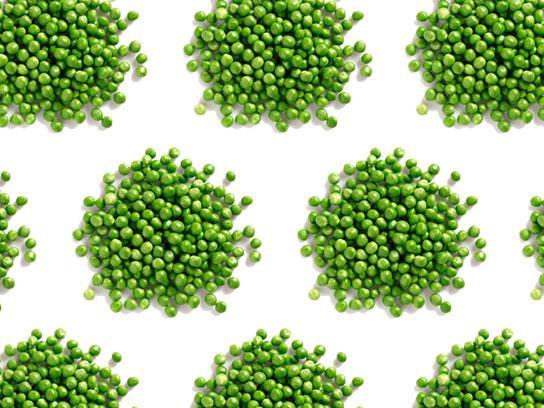

The first shoots appear in a couple of weeks. Sugar varieties grow rather slowly at first, so they will be clogged with grass. During this period, the plants need weeding.
A little later, you need to put the trellises at a distance of half a meter. The plants will trail up and hold on tightly to the net, this will prevent the wind from sprouting, and it will be easier for you to harvest. And the greens of the peas look very good on the site.
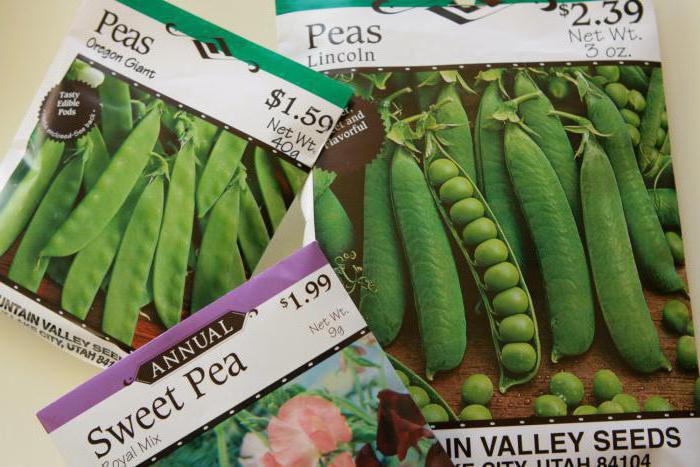

As for leaving, it comes down to watering and weeding. Plants begin to bear fruit, depending on the variety, this period, with careful care, stretches up to 35-40 days.
We hope that our article will be useful to you when choosing a variety of peas for home cultivation in personal plots, as well as tips for planting seeds. We wish you good luck and good harvests.
Low-growing varieties of peas
We recommend reading our other articles
- Why chickens lay small eggs
- Red currant jam
- Strawberry variety Lord
- Rabbits of breed White Giant
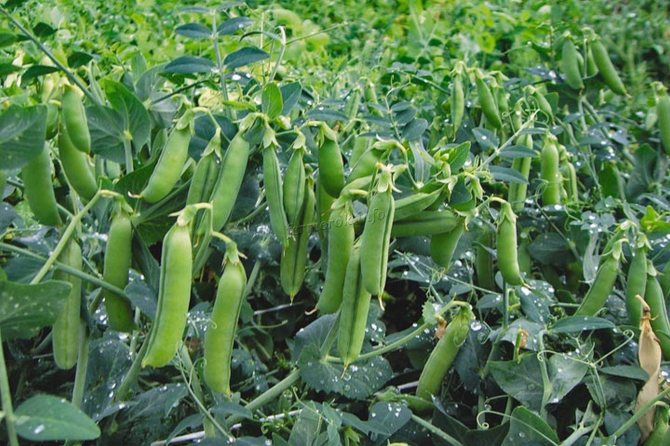

Stunted peas


Most varieties of peas have a tall stem, they curl and therefore are more often grown on a trellis or with a garter. Dwarf or undersized pea varieties are 30-70 cm tall, so they are much easier to grow. The garter needs a minimum, these types do not require serious and complex structures, and the yield is good.
- Alpha is an early shelling variety. Ripening period - 46-53 days. With good care, the yield reaches 2.8 kg / m. sq. The stems are low - 50-55 cm. The pods are up to 7 cm long, dark green, with a sharp top. The beans are large, round, green, sweet and juicy on the palate. It is used fresh or for processing.
- The Miracle of Callvedona is an early high-yielding sugar-type variety. Ripens in 60-75 days. The vine grows up to 55 cm, but more often lower. Pods up to 8 cm, with 7-8 large peas. The taste is excellent, it has a high protein content. The approximate yield per square meter is 0.58-1.2 kg.
- "Chinese" - mid-season sugar peas. Bushes up to 70 cm, grow quickly and give very long, beautiful pods up to 14 cm! Has a universal purpose. However, young peas of this type are best eaten fresh, as long as the grains are not more than 5-6 mm. At this time, they are the sweetest and most juicy.
- "Grandma's Surprise" is a very popular variety, giving bushes up to 65 cm in height. The pods are curved with a sharp top and a parchment layer. Pod length 8-10 cm, inside there are 8-10 peas of light green color. Up to 500 g of delicious pods are collected from a square meter.
Growing conditions
Requirements for conditions: Peas are a plant in a cool and relatively humid temperate climate. It is less sensitive to cold than that of beans and can germinate from + 5 ° C. Young plants (before flowering) can withstand frosts, but flowers can be damaged from -3.5 ° C, while vegetative organs from -6 ° C. The optimum average growth temperature is between +15 and + 19 ° C. At temperatures above + 27 ° C, growth slows down and normal pollination stops. The optimum rainfall for growing peas is between 800 and 1,000 mm per year. Peas are a typical long day plant. That is, it blooms quickly when the length of the day is maximum.
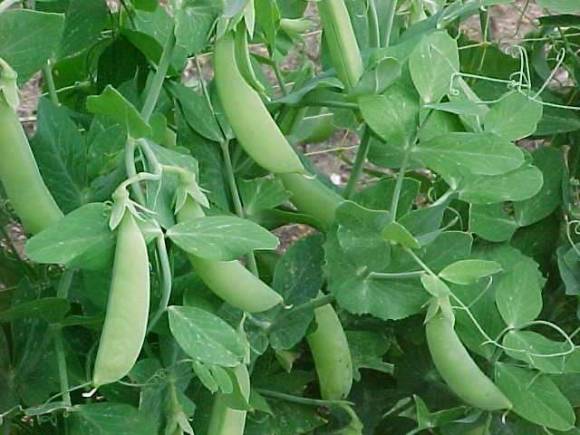

Peas adapt to all types of soils, but require good drainage and good water holding capacity of the soil. The optimum pH is between 5.5 and 7.0.
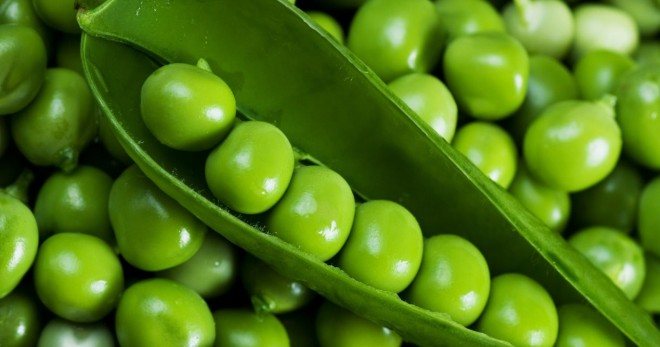

On the market, pea varieties are present in large quantities, which is good for the farmer or the owner of the dacha, but not everyone knows how to understand the huge catalogs. The seed of this valuable crop is classified into several categories, the names of which can confuse the inexperienced novice vegetable grower.
Planting dates for peas
The sowing time of this crop differs depending on the growing region. In the Urals and Siberia, peas are planted in June, and in the Kuban already in April.
The best varieties for Siberia:
- Altai emerald;
- Sugar cerebral.
The best varieties for the Urals:
- Alpha;
- Peas Berkut;
- Sprinter;
- Children's sugar;
- Adagumsky.
The best varieties for Central Russia:
- Early peas 301;
- Peas Afilla;
- Zhegalova 112.
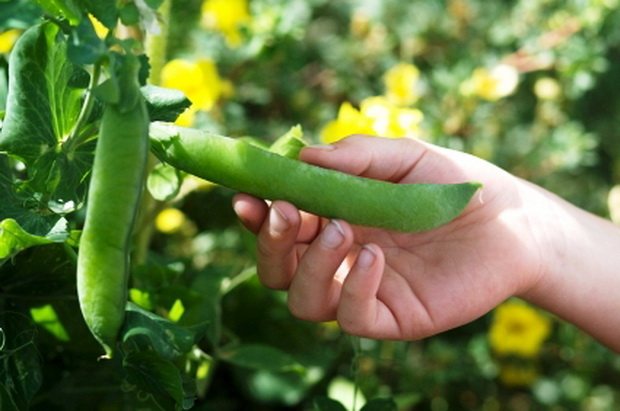

Early peas 301
The seeds of this culture germinate at a temperature of 2-5 ° C and they are not afraid of small frosts. These factors must be taken into account when planting peas outdoors. To harvest young peas longer, sow at intervals of 10-15 days.
Before planting, it is recommended to soak the seeds of sowing peas in salt water (30 g per 1 l) to discard low-quality seeds. Those peas that float up (usually they are affected by pests) are disposed of, those that have sunk to the bottom are suitable for planting. In order for the seedlings to be friendly, the seed should be germinated.
Peas do not like organic fertilizers. They must be introduced under its predecessors: cabbage, cucumbers or tomatoes.They will be enough for the peas next year.
Note! Nitrogen fertilizers should not be applied, peas synthesize this element themselves.
When growing crops in sandy loam soils, it is necessary to add molybdenum, due to which the yield will increase by 1.5 times. The acidity of the ground peas like neutral. If it is increased, the soil must be limed.
It is worth paying due attention to watering. Irrigation is essential while the peas are blooming and forming beans.
Important! Harvesting should be started about 14-15 days after flowering, when the fruit reaches milk ripeness. It is recommended to harvest sugar peas every 2-3 days.
Sweet peas straight from the garden are a favorite treat for children and adults. It ripens at the beginning of summer, when there are still not so many vitamin products in the garden. Peas are not afraid of spring frosts, so they can be planted very early. Caring for a crop is not particularly difficult, and even a novice gardener can grow it.
Vegetable peas are classified into two large groups:
- Peeling - the inner walls of its pods are lined with a thin "parchment" layer, which prevents the use of the whole shoulder blades for food.
- Sugar - which does not have such a layer inside. In the varieties of this group, not only peas, but also large, juicy and tasty pods (shoulder blades) are completely edible.
In sugar varieties, not only peas, but also pods at a young age can be eaten
In summer cottages, it is preferable to plant sugar varieties.
Pea varieties are both early and late. Harvesting times vary from one and a half to two and a half months, depending on the variety. Therefore, you can plant peas of different ripening periods on different beds or repeat the sowing of your favorite varieties with an interval of two weeks.
Peas are an extremely cold-resistant crop, so the air temperature does not greatly affect the timing. The first sowing of peas is carried out as soon as the soil dries out and it is already possible to work in the garden. In most regions, this is the beginning or mid-April, and in the north, it is the end of the same month. There is only a small difference to consider:
- smooth-grain varieties germinate even at a soil temperature of 1 ° C;
- cerebral - not lower than 4 ° C.
Based on this, smooth-grain varieties can be sown in open ground immediately after the snow melts, and cerebral varieties - one to two weeks later.
Peas easily tolerate a short-term cold snap, and under a snow cover they can withstand frosts down to -12 ° С
It happens that heat comes to the middle lane already in March. You can try sowing some peas during this period, and this way you will be able to get the earliest vitamin products.
The last sowing date for peas is early July. But in summer, the seeds may germinate worse, so the garden must be watered very well and must be mulched.
To increase the yield of the crop, many gardeners carry out pre-sowing seed treatment. This procedure is the same for all types of peas and is as follows:
- In order to ensure simultaneous germination, the seeds are heated in a bag for an hour and a half, placing them in any warm place (for example, near a battery).
Before planting, peas can be warmed up by hanging a bag of seeds on a warm pipe of the heating system. - Before sowing, the seeds can be treated with a solution of sodium chloride (2-3 tablespoons per 1 liter of water) in order to sort out specimens damaged by a pea weevil - such peas will quickly float up. After this treatment, the seeds must be thoroughly rinsed with clean water and dried thoroughly.
Do not soak and germinate pea seeds before sowing. This condition is especially important for brain varieties: if, after sowing, the soil temperature drops below 4 degrees Celsius, the young roots die off, and the seeds rot. Therefore, it is better to wait until the peas sprout on their own.
It is impossible to plant peas in one place for several years in a row, since diseases and pests accumulate in the soil. It is best to plant it in the garden on which it was previously grown:
- tomatoes;
- pumpkin crops (cucumbers, zucchini, pumpkins, squash);
- cabbage;
- potatoes.
The place on the site for sowing peas is chosen dry, open, sunny.
A good harvest of peas can be obtained by planting them in an open, sunny place.
Peas are plants that can store nitrogen, but they still need fertilizers for good growth. This crop is especially sensitive to the lack of molybdenum and boron in the soil. On poor and acidic soils, peas grow underdeveloped - they give two or three pods and dries up prematurely. Before planting, the soil in the garden must be prepared as follows:
- In order not to miss the early spring sowing dates, it is better to dig up the earth in the fall.
- Acidic soils must be calcified in advance.
Slaked lime or dolomite flour is used for liming the soil. - During digging, it is necessary to add nitrophosphate (60–80 g / m2) into the ground.
- The lack of molybdenum and boron can be compensated for by adding wood ash.
Ash is added to the soil before digging to replenish it with nutrients and reduce acidity - If during the autumn preparation of the ridges, organic fertilizers were not applied, then in the spring, before loosening the soil, humus or compost can be added - in a bucket per 1 m2.
Finally, the beds for planting peas are prepared before sowing. They are usually placed in the garden along the paths, guided by the following rules:
- For early ripening varieties, the ridges are made no more than 50-60 cm wide so that children can freely reach the pods from both sides. The pea beds can be of any size, but they must be accessible to children
- It is more convenient to place mid- and late-ripening pea varieties along the paths in narrow beds, where no more than two or three rows can be sown (then it is easier to put them on a support).
Peas are planted in the garden like this:
- Before sowing, transverse sowing grooves are made on wide ridges, and longitudinal sowing grooves on narrow ridges at a distance of 16-18 cm from one another.
- Water the beds with water and then spread the seeds one at a time to a depth of no more than 4–5 cm and at the same distance from each other.
Pea seeds are sown at a distance of 4-5 cm from each other - Cover the seeds with soil.
- After sowing, the garden bed is spilled with water again and mulched.
Pea care
Most pea varieties, with the exception of the smallest ones, require an obligatory support. Plants do not need to be tied to anything, they themselves cling to any partitions. You just need to remember about the props and prepare them as soon as the first hook antennae appear on the young pea shoots. They make supports like this:
- For early ripening and low-stemmed varieties, pegs no more than 50 cm high are placed on the garden bed.
- For varieties of medium ripening, the stems of which reach one and a half meters or more, flexible rods with a height of 1.5–2 m are vertically inserted along the rows. They are placed at a distance of 15–20 cm from each other; the upper ends are tied together. The support for the peas can be made from any materials at hand
Summer pea care comes down to infrequent watering (if there is no rain and the ground dries up). It is difficult to loosen the soil under adult plants due to the density and lodging of the stems, but dry mulch can be added during this period as well.
Weeding peas before and after flowering is not an easy task: uprooting weeds is dangerous because you can damage crops.
It is only recommended to prune the flowering tops of the weeds, as their stems are entwined with pea tendrils.
Sometimes peas are grown as seedlings. There is not much sense in this, but this technique allows you to get a harvest a little earlier. To do this, boxes with soil are installed in greenhouses or on a windowsill, into which seeds are densely sown (up to 2 thousand peas per square meter). Such seedlings are ready for planting in three weeks.
You can grow peas for seedlings without land at all, in the so-called hydroponics. In this case, a powerful root system in plants is formed in two weeks. After another 10-15 days, the seedlings are planted in a garden bed already with buds. At the age of one and a half months, the first harvest appears.
When growing plants without soil, a so-called three-layer toilet paper snail is often used as a substrate. They do it like this:
- The paper is spread on a plastic wrap and soaked.
- Pea seeds are laid out on top in an almost continuous row.
- The resulting structure is wound into a roll, plentifully pouring water over each layer.
- After the formation of roots, the "snail" is unrolled, the seedlings are carefully separated and planted in open ground.
The roots of most hydroponic plants grow strong and branchy.
To grow pea seedlings without the use of soil, plants must be provided with artificial supplementary lighting. When growing seedlings, daylight hours should reach 18 hours.
Peas grow remarkably in all conditions, but they form the best harvest at temperatures of 20-22 ° C. The climate of Belarus is ideal for growing this vegetable. Here peas are one of the most common vegetable crops.
In large agricultural enterprises of the country, cereal varieties of peas are sown a few days after the end of sowing of early grain crops, and in summer cottages and household plots - as soon as the soil allows.
Morphological structure
Peas belong to the legume family (Fabaceae). The most common species is the common pea (Pisum sativum). Let's consider its structure.
Root system
The root has a pivotal appearance, penetrates into the soil to a depth of about 1 meter. On the roots are nodule bacteria that assimilate nitrogen from the air and convert it into compounds available to the plant.
The structure of the pea seedling root is very simple. First, one core is formed without any additional branches.... Over time, additional formations grow at the root.
Stem and leaves
The stem of the plant is herbaceous, rounded, hollow inside. In most cases, lodging. For peas, special supports are installed, for which it clings with antennae and grows up. The stem can be up to two meters long.
Unusual types of peas
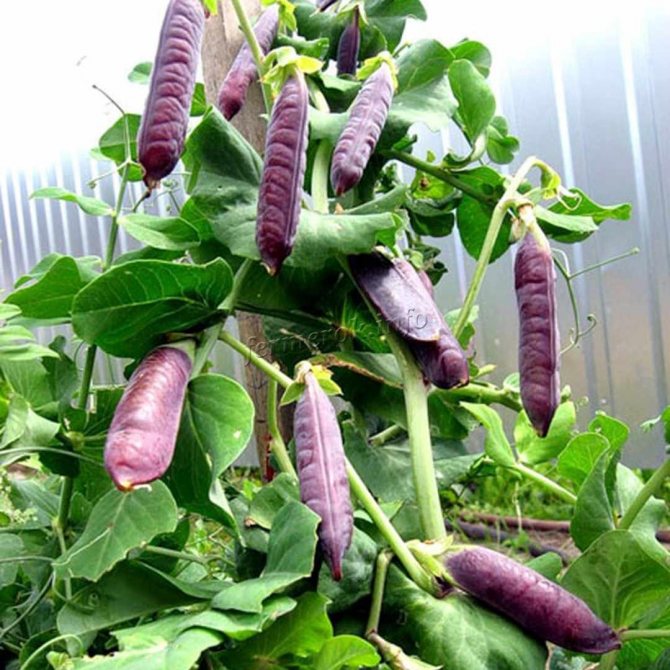

Fancy peas
Among the various types of peas, there are also unusual varieties of peas.
- "Blue Pod" is an interesting variety, which is not only a valuable, useful crop, but also a decoration of the site. It is a mid-season species that ripens in 70 days. Grows up to 150 cm, pods of 8-9 cm, blue-violet. They contain up to 9 green peas. After full ripening, the peas turn brown and wrinkle strongly.
- "Mustached nanny" refers to the so-called aphilic type - leafless varieties, in which some of the leaves have transformed into additional antennae. Ripening occurs in 60-65 days. Stems grow up to 80 cm, pods - up to 10 cm. Each pod contains about 7-9 green grains. Brain peas, sugar, very tasty. The entire pod is consumed, including the shutters.
- "Slider" is a leafless type of peas. The growing season is 53-55 days. Differs in a very long fruiting period. The bush grows up to 70 cm, unpretentious. The pods are slightly curved, but not strongly, of medium length. Each contains up to 9 peas.
Interesting!
With proper care, the crop is harvested in several stages until the first frost!
Choosing seeds in the store
When choosing seeds, you must pay attention to the fact that they are the same size, not damaged by pests. Outwardly, this is manifested by the presence of a cobweb, peas can be gnawed or damaged. The evenness of the planting material will allow you to get friendly shoots, which will facilitate subsequent care.
The mass of 1 thousand seeds ranges from 180 to 250 g. Germination rate is only 70%.
Up to 80 plants can grow on one square meter. Given the possible unfavorable conditions during the germination period, for growing plants per 1 sq. m. you need to purchase about 30 g of seeds (100 pcs.).
When buying, choose several varieties with different ripening periods. In this case, the harvest will be on the table throughout the warm season.
Pea diseases
For this culture, the most dangerous leaf roll, or pea moth. This is a small caterpillar that perfectly tolerates cold in the soil. The butterfly appears just before flowering and lays eggs on plants, from which caterpillars emerge and eat the harvest. To destroy leaf rollers, you can use both chemical and folk remedies: infusion of tomato tops and garlic. They are also effective in killing pea aphids.
Note! Of the diseases, powdery mildew affects peas. Here sow thistle infusion will come to the rescue.
Knowing everything about the types and timing of peas fruiting, you can choose the variety that is most suitable for the gardener (taking into account the region) and get a rich harvest at the end of the season. Moreover, you can grow a culture without even leaving the city - on the balcony. This vegetable doesn't require much attention and space.
Pea soil requirements
Peas, easily tolerating cold, are very capricious in relation to the soil. It does not grow on acidic soils; for normal growth and development, it needs loam or sandy loam with a neutral (or close to neutral) pH.
At FORUMHOUSE, we told you how to do home soil acidity tests on your site.
Acidic soil can be improved by deoxidation, adding for each square meter either 300 g of slaked lime, or 400 g of dolomite flour.
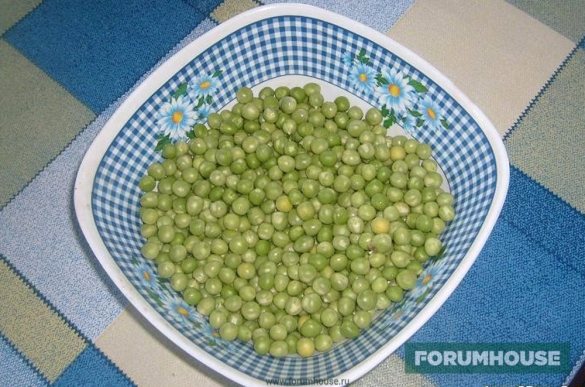

It will not be possible to harvest a good harvest of peas even on heavy, dense, clayey soils - the problem is that on clay, the roots of peas creep in the surface layer and do not produce nitrogen themselves, as in light and fertile soil. In clayey soil, peas cease to be a nitrogen accumulator and become a nitrogen consumer. Therefore, you can try to improve the clay soil by adding additional distillation, etc. And be sure to add a bucket of sand for every meter of soil.
But for peas, the predecessors are practically unimportant, it can be sown after any crop, except for the legumes themselves: an infection that is dangerous for pea plants can accumulate in the soil. It is also better not to sow peas near the lawn: pests unwanted for peas can live on it.


